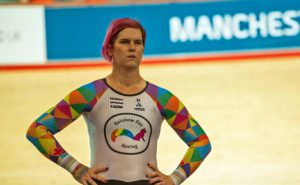What could Florida’s legislation banning the teaching of gender identity to children possibly have in common with the skinny-jean devotees known as hipsters? Only that both movements are responses to the unraveling of settled gender roles that is one of the most transformative events of our lifetimes.
The fact that the unraveling is taking place is one of the few points on which the Right and Left can agree. Both sides take for granted the collapse of the traditional “gender binary” and its replacement by a novel and fluid suite of gender identities. The disagreement is over whether this represents freedom and progress or coercion and decadence.
Many on the Left argue that a teacher should be allowed to counsel children on their sexual identity and introduce them to academic gender theories. They argue that socialising young children to embrace concepts such as gender fluidity and “birthing person” is essential to the student’s civic education and personal development. Their opponents reject these efforts as a political intrusion into the domain of moral and sexual education that should belong to parents.
But the political and cultural debates, which focus on ideology and government policy, ignore the crucial role that technological and economic revolutions are playing in replacing the male-female dyad with a new virtual multiplicity of gender expressions.
In the first decade of the new millennium, amid the talk of terrorism, war, clash of civilisations, and global financial meltdown, there was an accompanying cultural preoccupation with hipsters. For at least a decade, this seemingly trivial youth subculture dedicated to vintage t-shirts, anti-consumerist “indie” consumerism, trucker hats, and a self-referential style, seemed to be a leading concern of America’s chattering class.
“What was the Hipster?” asked N+1, the premier journal of New York’s young intellectual scene in a 2011 symposium and subsequent book that provided a formal historiography for the subculture which, by then, appeared to be in decline.
In a more thorough analysis than most commentary from the time, N+1’s Mark Greif argued that hipsterism was not merely a set of fashions and aesthetic choices, but the product of an interaction between larger cultural and economic forces. In America’s urban cultural capitals in the early 2000s, Grief wrote: “The indie bohemians (denigrated as slackers) encountered the flannel-clad proto-businessmen and dot-com paper millionaires (denigrated as yuppies), and something unanticipated came of this friction.”
The emblematic hipster trousers, haircuts and bands that were popping up in Williamsburg, Silver Lake and Shoreditch represented a cultural evolution. The old skin suited to a factory-production-based economy and its attendant white-collar professions was being shed, and a new one adapted to the post-industrial knowledge economy was growing. Hipsterism was the cultural manifestation of a stratifying information society in which the caste of the professional class came to express its status through an ornate language of tastes and luxury beliefs.
“The postindustrial economy is indifferent to brawn,” wrote the journalist Hannah Rosin in her 2012 book The End of Men: And the Rise of Women. “A service and information economy rewards precisely the opposite qualities,” Rosin continues. “Social intelligence, open communication, the ability to sit still and focus — are, at a minimum, not predominantly the province of men. In fact, they seem to come more easily to women.”
The new economy thus laid a new material foundation for gender relations.
From the beginning, the hipster sensibility contained a reaction against the success of the women’s movement. Norman Mailer, author of the 1957 essay “The White Negro: Superficial Reflections on the Hipster” and forefather of the modern middle-class hipster genre, was openly hostile to the women’s movement, which he criticised at length in books and public debates for being humourless, sexless, and refusing to grapple with the biological differences between the sexes.
A half century after Mailer’s essay, latter-day hipsters preserved the boyish, performative elements of his reaction against feminism but divorced it from any political content. Instead of Mailer’s philosophical critique, they popularised an amateur pornography aesthetic in photography and music videos and ushered in a campy revival of macho fashions such as mustaches, woodsman beards, and trucker hats. Certainly in America, anyway.
These anti-feminist fashions were, however, only one aspect of a sensibility that was less a platform for modeling a specific masculine ideal than a stage on which conflicting impulses and concerns about gender norms could be acted out and then obsessively analysed. “At the same time that hipsters were dressing like Seventies-model Stanley Kowalskis,” wrote Greif, “they were consuming culture that was considerably more anxious about machismo, heterosexuality, and maturity.” Other hipster looks such as skinny jeans also played against traditional ideas of masculinity.
Hipster artists could be criticised as closet sexists who hid their chauvinistic attitudes in layers of irony. Or they could be written off as dandys, too twee to make anything truly moving or lasting. In either case, hipster was not only a way of describing and critiquing a type of youth fashion, it was pointed to something different in contemporary manhood.
Meanwhile, the rise of hipsters coincided with and accelerated the mainstreaming of postmodern themes in popular discourse. The professional classes, already prone to self-examination, could not help but notice around the turn of the millennium that amid the digital boom, their lives were becoming more curated and self-conscious, increasingly mediated through data and simulations, and suffused with ironic detachment.
There followed what you might call an irony panic. Every few months a new think piece appeared in a glossy magazine declaring the death of irony or heralding its rebirth. The suspicion of irony and relentless inspection of authenticity focused mostly on male artists, like the musician Beck, the writer Dave Eggers, and the filmmaker Wes Anderson.
It was possible to notice all this at the time without taking any of it seriously. “It’s easy to let this hypothesizing go too far, and you get into trouble when you try to charge hipsters with representing the ‘ethos of our age,’” warns a 2012 essay in The Atlantic. Hipsters were “just kids making their way from young adulthood to the rest of their lives”. Much of the hipster commentary was absurdly overinflated — wasn’t it ridiculous to make so much out of something so frivolous? But the young American intellectuals who saw it as their duty to analyse and interpret and, eventually, treat the culture, really did spend years concerned in all and high seriousness, with hipsters. And part of what drove that persistent fascination, I would suggest, is that the figure of the hipster spoke to fundamental changes in men and women and the relations between them.
There was something unreconciled, if not schizophrenic, in the hipster outlook, which both venerated personal authenticity and assumed unlimited freedom for individuals to construct new identities through their tastes and consumer choices. But in its own ridiculous way, the hipster phenomenon anticipated the burgeoning gender experimentations that would shape the social-media-driven youth subcultures of the 2010s, which, in turn, fed into the current political wars over gender and sex education. The strange political evolution of the past decade has seen the same anxieties about gender and authenticity once present in the ironic and whimsical poses of hipsters harden into articles of the most humourless, irony-resistant political dogmas.
Through a process of cultural evolution that was driven by networked social technologies, the same hipster’s subcultural gender performances of the 2000s were succeeded in the 2010s by a creed of speculative gender absolutism. Rather than demanding to know whether an individual’s self-expression was ironic or authentic, as had previously been the norm, the new style of gender activism presupposed that subjective statements concerning gender not just true but ontologically valid.
In the subcultural firmament that emerged on digital platforms such as Tumblr and spread rapidly through Twitter, the post-structuralism of gender theorists such as Judith Butler which had once been the province of academics and activists, was treated as ground-level truth. Involuted treatises presenting gender as a social construction with no innate characteristics flourished online and yielded an expanding array of virtual identities. The effect of these changes is neatly encapsulated in the ever expanding list of pronouns, such as the one in a curriculum recently adopted by a school district in Illinois, where teachers instruct first graders that they can choose from options that include “she”, “he”, “tree”, “ze”, and “zir”, among other choices.
Whereas the characteristic attitude in the adult world toward earlier youth subcultures, including hipsters, tended to be a mix of condescension and alarmism, this was reversed over the past decade as the online forums for gender experimentation fed into and were fed by the growing power of social justice activists.
In a progression that is still scarcely believable, post-structuralist theories that were first transmitted from academic theorists and activists to young people exploring their capacity for self-invention, were then adopted as mantras by the most powerful political figures in the United States.
It’s not simply that a phrase such as “birthing person”, used in President Biden’s 2022 budget proposal to refer to pregnant women, would have been unrecognisable to earlier generations. Beyond the change in language, the ideologically sterilised concept of maleness and femaleness it represents is a deliberate step away from biological and theological understandings of what it means to be human, and into a realm of totalling political authority.
Progress marches on and hipsters, once so determined to stay on the cutting edge, now seem positively rooted and organic compared with the era of online trolls and Tumblr identity fundamentalists who replaced them and in turn seeded a new sense of reality. Can anyone imagine a George W. Bush era Supreme Court nominee answering, “I’m not a biologist” when asked whether they can provide a definition for the word “woman”. That is exactly what happened when the question was posed to Biden nominee Ketanji Brown Jackson, who has now been confirmed as America’s newest Supreme Court Justice. It was a trick question of course, but the fact that such a question can be a trick is telling. Countless media commentaries appeared in American publications assuring readers that Jackson is on the side of “the science” showing that defining a woman is righteously complicated.
Parents in Florida and elsewhere are under no obligation to investigate the gendered dimensions of techno-capitalism before deciding whether they are comfortable with their children being taught from handbooks that are designed to sever the connection between sex and biology. Yet, if they are curious about the deeper currents at work and why it is impossible — even if conservatives were to take control over every cultural institution tomorrow — to revert to traditional gender roles that have been wiped away by economic revolutions that most conservatives once embraced, they may find that, against all odds, the hipster offers an illuminating historical example.
Disclaimer
Some of the posts we share are controversial and we do not necessarily agree with them in the whole extend. Sometimes we agree with the content or part of it but we do not agree with the narration or language. Nevertheless we find them somehow interesting, valuable and/or informative or we share them, because we strongly believe in freedom of speech, free press and journalism. We strongly encourage you to have a critical approach to all the content, do your own research and analysis to build your own opinion.
We would be glad to have your feedback.
Source: UnHerd Read the original article here: https://unherd.com





